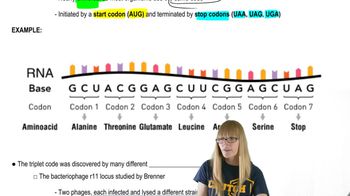Mutations in the low-density lipoprotein receptor (LDLR) gene are a primary cause of familial hypercholesterolemia. One such mutation is a SNP in exon 12 of the LDLR. In premenopausal women, but not in men or postmenopausal women, this SNP leads to skipping of exon 12 and production of a truncated nonfunctional protein. It is hypothesized that this SNP compromises a splice enhancer [Zhu et al. (2007). Hum Mol Genet. 16:1765–1772]. What are some possible ways in which this SNP can lead to this defect, but only in premenopausal women?
Table of contents
- 1. Introduction to Genetics51m
- 2. Mendel's Laws of Inheritance3h 37m
- 3. Extensions to Mendelian Inheritance2h 41m
- 4. Genetic Mapping and Linkage2h 28m
- 5. Genetics of Bacteria and Viruses1h 21m
- 6. Chromosomal Variation1h 48m
- 7. DNA and Chromosome Structure56m
- 8. DNA Replication1h 10m
- 9. Mitosis and Meiosis1h 34m
- 10. Transcription1h 0m
- 11. Translation58m
- 12. Gene Regulation in Prokaryotes1h 19m
- 13. Gene Regulation in Eukaryotes44m
- 14. Genetic Control of Development44m
- 15. Genomes and Genomics1h 50m
- 16. Transposable Elements47m
- 17. Mutation, Repair, and Recombination1h 6m
- 18. Molecular Genetic Tools19m
- 19. Cancer Genetics29m
- 20. Quantitative Genetics1h 26m
- 21. Population Genetics50m
- 22. Evolutionary Genetics29m
13. Gene Regulation in Eukaryotes
Overview of Eukaryotic Gene Regulation
Problem 28
Textbook Question
Marine stickleback fish have pelvic fins with long spines that provide protection from larger predatory fish. Some stickleback fish were trapped in lakes and have adapted to life in a different environment. Many lake populations of stickleback fish lack pelvic fins. Shapiro et al. (2004) (Nature 428:717.723) mapped the mutation associated with the loss of pelvic fins to the Pitx1 locus, a gene expressed in pelvic fins, the pituitary gland, and the jaw. However, the coding sequence of the Pitx1 gene is identical in marine and lake stickleback [Chan et al. (2010). Science 327:5963,302–305]. Moreover, when the Pitx1 coding region is deleted, the fish die with defects in the pituitary gland and the jaw, and they lack pelvic fins. Explain how a mutation near, but outside of, the coding region of Pitx1 may cause a loss of pelvic fins without pleiotropic effects on the pituitary gland and jaw.
 Verified step by step guidance
Verified step by step guidance1
Understand that the Pitx1 gene is expressed in multiple tissues: pelvic fins, pituitary gland, and jaw, and that mutations in the coding region affect all these tissues, causing pleiotropic effects.
Recognize that the coding sequence of Pitx1 is identical in both marine and lake stickleback fish, so the difference in pelvic fin development is not due to changes in the protein itself.
Consider that gene expression can be regulated by sequences outside the coding region, such as enhancers or promoters, which control when and where the gene is turned on.
Hypothesize that a mutation near but outside the Pitx1 coding region could disrupt a tissue-specific enhancer responsible for activating Pitx1 expression only in pelvic fins, without affecting its expression in the pituitary gland or jaw.
Conclude that this regulatory mutation would lead to loss of Pitx1 expression specifically in pelvic fins, causing their loss, while leaving Pitx1 function intact in other tissues, thus avoiding pleiotropic effects.
 Verified video answer for a similar problem:
Verified video answer for a similar problem:This video solution was recommended by our tutors as helpful for the problem above
Video duration:
1mPlay a video:
Was this helpful?
Key Concepts
Here are the essential concepts you must grasp in order to answer the question correctly.
Regulatory Mutations and Gene Expression
Mutations outside the coding region, such as in enhancers or promoters, can alter when, where, or how much a gene is expressed without changing the protein sequence. In this case, a mutation near Pitx1 may disrupt pelvic fin-specific enhancers, reducing Pitx1 expression only in pelvic fins, while leaving expression in other tissues intact.
Recommended video:
Guided course

Penetrance and Expressivity
Pleiotropy and Tissue-Specific Gene Regulation
Pleiotropy occurs when one gene influences multiple traits or tissues. Pitx1 affects pelvic fins, pituitary gland, and jaw development. Tissue-specific regulatory elements allow a gene to be expressed differently in each tissue, so mutations in specific enhancers can affect one trait without causing defects in others.
Recommended video:
Guided course

Pleiotropy
Functional Importance of Coding vs. Non-Coding Regions
The coding region of a gene determines the protein’s structure, while non-coding regions control gene expression patterns. Identical coding sequences with different phenotypes suggest that changes in non-coding regulatory DNA, rather than protein structure, underlie phenotypic differences such as loss of pelvic fins.
Recommended video:
Guided course

The Genetic Code
Related Videos
Related Practice
Textbook Question
729
views


